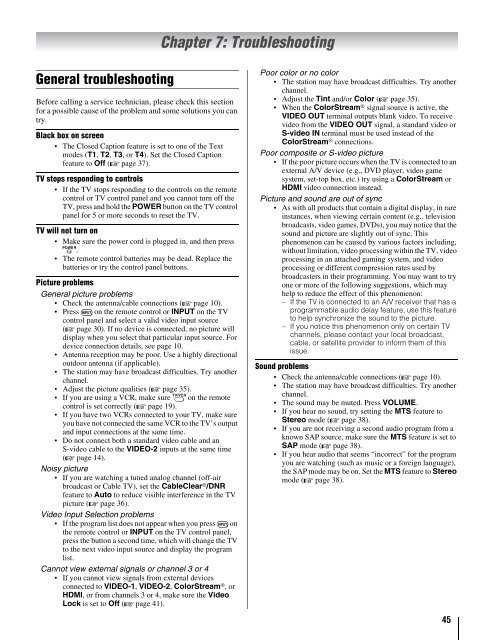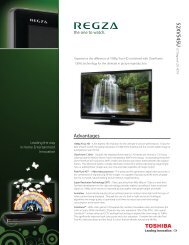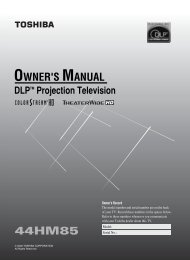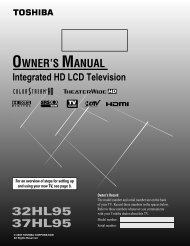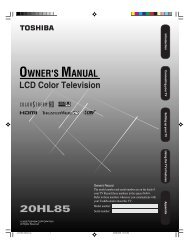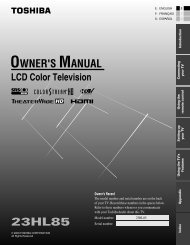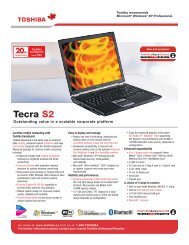26HL86 32HL86 37HL86 LCD Color Television - Toshiba Canada
26HL86 32HL86 37HL86 LCD Color Television - Toshiba Canada
26HL86 32HL86 37HL86 LCD Color Television - Toshiba Canada
Create successful ePaper yourself
Turn your PDF publications into a flip-book with our unique Google optimized e-Paper software.
General troubleshooting<br />
Before calling a service technician, please check this section<br />
for a possible cause of the problem and some solutions you can<br />
try.<br />
Black box on screen<br />
The Closed Caption feature is set to one of the Text<br />
modes (T1, T2, T3, or T4). Set the Closed Caption<br />
feature to Off (- page 37).<br />
TV stops responding to controls<br />
If the TV stops responding to the controls on the remote<br />
control or TV control panel and you cannot turn off the<br />
TV, press and hold the POWER button on the TV control<br />
panel for 5 or more seconds to reset the TV.<br />
TV will not turn on<br />
Make sure the power cord is plugged in, and then press<br />
p.<br />
The remote control batteries may be dead. Replace the<br />
batteries or try the control panel buttons.<br />
Picture problems<br />
General picture problems<br />
Check the antenna/cable connections (- page 10).<br />
Press + on the remote control or INPUT on the TV<br />
control panel and select a valid video input source<br />
(- page 30). If no device is connected, no picture will<br />
display when you select that particular input source. For<br />
device connection details, see page 10.<br />
Antenna reception may be poor. Use a highly directional<br />
outdoor antenna (if applicable).<br />
The station may have broadcast difficulties. Try another<br />
channel.<br />
Adjust the picture qualities (- page 35).<br />
If you are using a VCR, make sure L on the remote<br />
control is set correctly (- page 19).<br />
If you have two VCRs connected to your TV, make sure<br />
you have not connected the same VCR to the TV’s output<br />
and input connections at the same time.<br />
Do not connect both a standard video cable and an<br />
S-video cable to the VIDEO-2 inputs at the same time<br />
(- page 14).<br />
Noisy picture<br />
If you are watching a tuned analog channel (off-air<br />
broadcast or Cable TV), set the CableClear ® /DNR<br />
feature to Auto to reduce visible interference in the TV<br />
picture (- page 36).<br />
Video Input Selection problems<br />
If the program list does not appear when you press + on<br />
the remote control or INPUT on the TV control panel,<br />
press the button a second time, which will change the TV<br />
to the next video input source and display the program<br />
list.<br />
Cannot view external signals or channel 3 or 4<br />
If you cannot view signals from external devices<br />
connected to VIDEO-1, VIDEO-2, <strong>Color</strong>Stream ® , or<br />
HDMI, or from channels 3 or 4, make sure the Video<br />
Lock is set to Off (- page 41).<br />
Chapter 7: Troubleshooting<br />
Poor color or no color<br />
The station may have broadcast difficulties. Try another<br />
channel.<br />
Adjust the Tint and/or <strong>Color</strong> (- page 35).<br />
When the <strong>Color</strong>Stream ® signal source is active, the<br />
VIDEO OUT terminal outputs blank video. To receive<br />
video from the VIDEO OUT signal, a standard video or<br />
S-video IN terminal must be used instead of the<br />
<strong>Color</strong>Stream ® connections.<br />
Poor composite or S-video picture<br />
If the poor picture occurs when the TV is connected to an<br />
external A/V device (e.g., DVD player, video game<br />
system, set-top box, etc.) try using a <strong>Color</strong>Stream or<br />
HDMI video connection instead.<br />
Picture and sound are out of sync<br />
As with all products that contain a digital display, in rare<br />
instances, when viewing certain content (e.g.. television<br />
broadcasts, video games, DVDs), you may notice that the<br />
sound and picture are slightly out of sync. This<br />
phenomenon can be caused by various factors including,<br />
without limitation, video processing within the TV, video<br />
processing in an attached gaming system, and video<br />
processing or different compression rates used by<br />
broadcasters in their programming. You may want to try<br />
one or more of the following suggestions, which may<br />
help to reduce the effect of this phenomenon:<br />
– If the TV is connected to an A/V receiver that has a<br />
programmable audio delay feature, use this feature<br />
to help synchronize the sound to the picture.<br />
– If you notice this phenomenon only on certain TV<br />
channels, please contact your local broadcast,<br />
cable, or satellite provider to inform them of this<br />
issue.<br />
Sound problems<br />
Check the antenna/cable connections (- page 10).<br />
The station may have broadcast difficulties. Try another<br />
channel.<br />
The sound may be muted. Press VOLUME.<br />
If you hear no sound, try setting the MTS feature to<br />
Stereo mode (- page 38).<br />
If you are not receiving a second audio program from a<br />
known SAP source, make sure the MTS feature is set to<br />
SAP mode (- page 38).<br />
If you hear audio that seems “incorrect” for the program<br />
you are watching (such as music or a foreign language),<br />
the SAP mode may be on. Set the MTS feature to Stereo<br />
mode (- page 38).<br />
45


